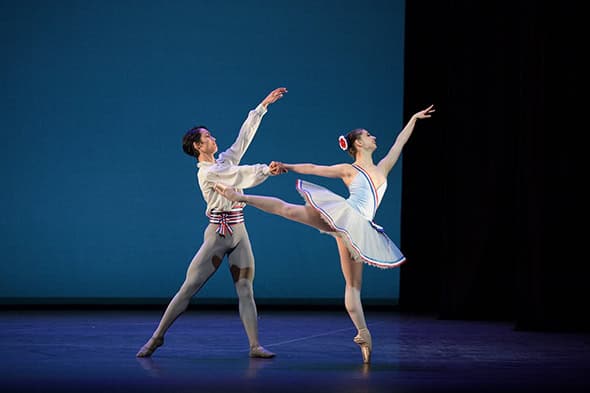English National Ballet Emerging Dancer Award 2019
Posted: May 14th, 2019 | Author: Nicholas Minns | Filed under: Competition, Performance | Tags: Alice Bellini, Emerging Dancer 2019, Emilia Cadorin, Fabian Reimar, Gavin Sutherland, Julia Conway, Miguel Altunaga, Nuno Campos, Rentaro Nakaaki, Rhys Antoni Yeomans, Sebastian Kloborg, Shale Wagman, Sofie Vervaecke, Tamara Rojo, William Forsythe | Comments Off on English National Ballet Emerging Dancer Award 2019English National Ballet, Emerging Dancer Award 2019, Sadler’s Wells, May 7

Appearances can be deceptive. On the cover of English National Ballet’s program for Emerging Dancer, the six contestants have been photographed by Laurent Liotardo (post production by Nik Pate) in various sharply delineated, sculptural poses. If the athleticism of these images were to represent the odds of winning, Shale Wagman and Rhys Antoni Yeomans would be in close competition for the prize. Even looking at them on stage as they enter with their respective partners for the pas de deux section, they embody the classical image of the male dancer; perhaps Yeomans has the edge in musculature. But shape is only one element of classical dance; moving between shapes in a rhythm that derives from music is another. Here both Wagman and Yeomans fail to follow up on the promise of their initial images. Wagman is lean and flexible — as he demonstrates abundantly in his contemporary solo — but since so much virtuoso male dance takes place in the air he needs to work on elevation. Yeomans has a better jump but while he can turn exquisitely on the ground he shares with Wagman a malfunctioning ‘spot’ in aerial tours. If ‘emerging dancer’ means the process of polishing rough potential into a physically expressive dancing body Wagman and Yeomans have applied the polish before the expression. Rentaro Nakaaki hasn’t yet arrived but his rough potential is exciting; there are times when his form shows through and he is not afraid to take risks. He has an arsenal of virtuoso steps that overflow with enthusiasm if not attention to line and shape and his character is refreshingly open. Even though he didn’t win he gained my vote for sheer ebullience in the process of emerging.
Liotardo’s photographs of the three women — Alice Bellini, Emilia Cadorin and Julia Conway — are less exciting and fail to distinguish the character of each; Cadorin’s and Conway’s are almost identical. Onstage, however, Conway emerges with the poise and control that deservedly earns her this year’s award. Interestingly she is paired with Nakaaki dancing a pas de deux from Vasily Vainonen’s Flames of Paris. It’s a size too big for Nakaaki at this point in his development but his youthful attack allows Conway to appear calm and assured in her own variations; he’s the storm and she’s its eye. Bellini is paired with Wagman in Victor Gzovsky’s Grand Pas Classique; he’s attending more to the audience than to her which unglues the partnership, but she has a lyrical quality that shines. Cadorin dances Coppélia with Yeomans who is a more boyishly attentive partner. On this occasion Cadorin’s spirit is strong but her upper back — and thus her port de bras — seems constricted so she cannot flow with the romantic sentiment in the music.
The second stage of the competition requires each dancer to perform a contemporary solo of their own choice. Presumably the idea is for the judges and audience to see another aspect of each contestant in terms not only of physical ability but of individual expression. Unlike the classical variations, here the choreography for the most part draws attention to itself, leaving the dancers in the passenger seat; when they are driving there’s a touch of indulgence, as in Wagman’s solo by Sofie Vervaecke, Peculiar Mind. Bellini needs a far more theatrical vehicle for her talents than CLAN B, Sebastian Kloborg’s spoof on La Sylphide, and although Yeomans chooses a great solo by Forsythe, he is left somewhat deflated in the middle by not hitting those glorious accents in Thom Willems’ lush, percussive score. Fabian Reimair’s BAM! for Cadorin doesn’t achieve its title’s promise for her by not giving her enough traction, partly a problem with Reimar’s own score. Nuno Campos gives Nakaaki the one work of the evening that seems tailored for him, showing him in a lean, introspective light; it’s called, appropriately, Own. Similarly Miguel Altunaga’s Untitled Code gives Conway a vehicle for her clarity of expression and keen gestural sense that she carries over from Flames of Paris.
On its tenth anniversary the Emerging Dancer Award celebrates after an intermission with a performance by Francesca Velicu and last year’s award winner, Daniel McCormick in the pas de deux from Act III of Don Quixote. McCormick is a fine dancer but my eyes are drawn to a quality in Velicu that has been missing over the course of the evening: the ability to make the music visible. All Gavin Sutherland’s efforts in the pit directing the English National Ballet Philharmonic have been rewarded.